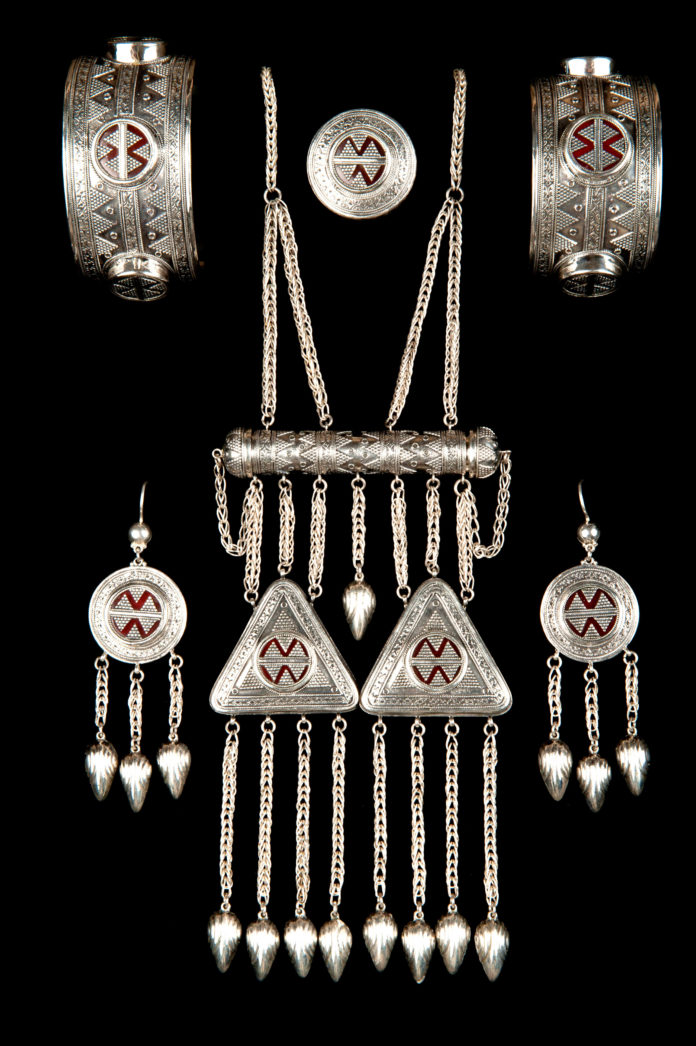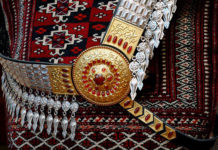Zergerlyk is a traditional Kazakh art of jewellery making. This art is transferred through generations from father to son, from master to journeyman. Each zerger (jewellery artist) works on its own. Zergerlyk is considered a professional art.
Archeological findings suggest that Kazakh people achieved a higher level in the development of jewellery making. Chylik findings were made using such techniques as stamping, engraving, true grain, incrustation (VII-V century BC); Issyk finding included “Golden warrior” (IV-III century BC); Berel kurgan findings (IV-VI century BC) from Eastern Kazakhstan are the testimony of a unique “animal style” in jewellery making.

Jewellery is mainly made with silver. This craft is widespread across Kazakhstan but each region has its specifications concerning technique and design. Jewellery sets are made for men, women, and children; as well jewellery making is used for decorating musical instruments, household items, weaponry and horse gears; some made for rituals, others have symbolic or sacred value. Zergerlyk used for making details in men’s clothing, rider’s gear, horse riding gear, for example, horse equipment (er-tuman), traditional belts (beldyk, kyseh beldyk and kyemer belbeu), sword and knives’ handles and scabbards, powder flask (okhshantai), snuffboxes (nasybai). Women’s decorative items include forehead jewellery (shekelyk), braid jewellery (shashbau), earrings (syrgha), necklaces (alkhah, onirzhiyek, tumar), bracelets and cuffs (bilezyk), rings (zhuzyk), belt buckles (khapsyrmah), buttons (tyuime), personal hygiene items (tyss tazlaghysh, khulakh tazlaghysh), tools for crafting, spindle (urshykh), thimble (oymakh). Zergers also make child’s cradle set: bessyk (cradle), shumek (tube to flow urine), syldyrmakh (rattle), yemyzik (pacifier), tumar (amulet, charm) and other items.
The jewellery pieces in the form of circle, oval, triangle, half oval, rectangular, petal, peak and beak are frequently combined to make a larger piece, for example pectoral decorative items onzhyrek and alkah are made of several triangle and rectangular plates, khudaghy zhuzik (a special large double ring presented when marriage brokerage occurs) and bes-blezyk (a bracelet connected with chains with three rings).
Geometric style from Western Kazakhstan is famous for large-scale decorative items that are assembled from pre-made pieces that are joined together by soldering (plates, borders, solar symbols, grain). Most common techniques include true grain, plated filigree, stamping, embossing, engraving, niello, enamel, casting, forging, and incrustation with precious and semi-precious stones. Stone (tas) are sliced flat and are called koz (eye) as they considered to be protection charms. The most popular stone is cornelian (akhykh) as it symbolizes prosperity and joy.
Silver decorative items accompany Kazakh people for the whole life from the moment they are born till the day they leave this world. Wearing silver bracelets and rings was required when women were cooking. As well, traditional jewellery plays an important role in Kazakh society as it helps to immediately recognise the status of a person (young woman, engaged woman, married, parents with children that not married, parents with married children, ruler, shaman or other).
Modern zergers/jewellery artists include K. Kulmambetov, A. Mukhazhanov, Ye. Daubay, B. Aleebay, S. Kokenov, B. Atamkulov, S, Bashirov, S. Rysbekov, A. Khadyrbayev, Yi. Kazakov, S. Orazov, K. Tassov, Yi. Rafikov, K. Yesmakhan, A. Mustafayev, S. Umytbayev, A. Zheldybayev and Z. Yuldabayev.





